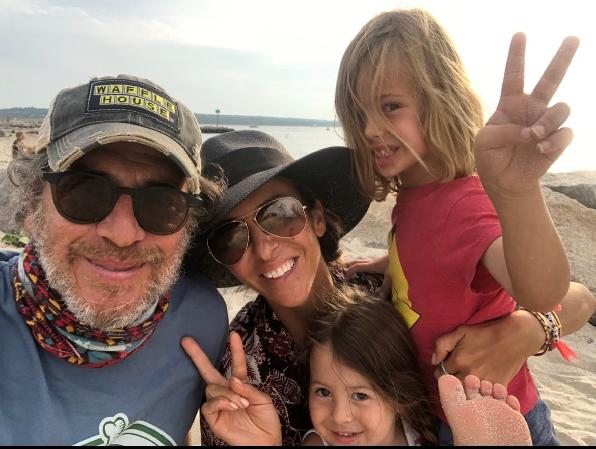Please note that some translations using Google Translate may not be accurately represented and downloaded documents cannot be translated. Dana-Farber and the Jimmy Fund assume no liability for inaccuracies that may result from using this third-party tool, which is for website translation and not clinical interactions.

WHY WE'RE FUNDRAISING WITH THE JIMMY FUND WALK TO FIGHT CANCER
To Friends, Family, Friends of Family, and Family of Friends:
In September of 2021 Scott and I were shocked and devastated beyond words to learn that my breast cancer from 2017 had returned and spread to my bones, my peritoneum, and my brain. The medical community tells me I make up the .1 percent of people this has happened to. Not 1 percent. Point 1 percent. So, yes that makes me a unicorn of sorts, worthy of lots of attention. And we all know how much I love being the center of attention.
Until now.
Some backstory: in 2017, I was diagnosed with Ductal Carcinoma In Situ (DCIS). DCIS is classified as Stage Zero breast cancer. It is so relatively benign that there was a time it was not even considered cancer, but rather pre-cancer. Because it is confined to the milk ducts, it is incapable of spreading. If you are going to get breast cancer, it is the best breast cancer to get. So, yes, in The Breast Cancer Lottery, you could say we were winners. My team of doctors all agreed that getting a lumpectomy was the best treatment option. But then we got another bout of shocking news. I tested positive for the BRCA 2 gene mutation. It is an inherited gene where people’s tumor suppressor genes are mutated, allowing cancers to form. About 13 percent of women will develop breast cancer by the time they are 80 years old. In BRCA2 carriers, 45-69 percent of women will develop breast cancer by the time they are 70-80 years old.
We made the decision to move forward with a double mastectomy and reconstruction. With a mastectomy, I could be done worrying about a breast cancer diagnosis in the future. We assembled a dream team of doctors and in December of 2017, I underwent the scariest surgery of my life. I ended up being under anesthesia for 8 hours and the recovery was just brutal. At the time, Sawyer was only nine months old, yet I was strictly forbidden from lifting anything. Sawyer would just have to wait a few more months to be held by her mama. At least she was going to have her mama for a very long time, I remember thinking to myself.
A week after surgery the pathology report came back confirming there was no lymph node involvement and that the margins were clear. When breast cancer is surgically removed, the doctor also removes a rim of normal tissue surrounding the cancerous tissue and has it tested. If there’s no cancer in the normal tissues, margins are considered clean and no subsequent intervention is recommended. According to all four of my doctors, I was virtually guaranteed never to have a recurrence of breast cancer for the rest of my life.
In June of 2020, due to Covid, we relocated our family to Martha’s Vineyard. I can honestly say that, despite the apparent success of the surgeries, my health and headspace felt subpar. But come on, whose didn’t during that time? Yet overall, life was good. We settled into the cozy rhythms of island living. The kids thrived at school. Scott wrote his butt off. And I perfected both a tuna casserole and a cacio y pepe with equal aplomb.
But in July 2021, my left eye began to noticeably droop, as if it had suddenly become lazy. I showed it to Scott and several of our friends who were visiting and we all just assumed it to be a stye and that, like all styes, it would resolve itself in a few days. But it did not. Instead, my eye became even more asymmetric. And worse, my vision became compromised and I started to have inexplicable headaches. I was referred to Dr. Suzanne Freitag, Head of Ophthalmological Surgery at Boston Eye and Ear. After a cursory examination, Dr. Freitag told her assistant to schedule an MRI for that day. “But, it’s not cancer, right?” I remember asking. She said most likely not. It could be an autoimmune disease, could be a neurological disorder, or could be something far less serious. But she assured me that she was going to figure it out. That day was awful. MRIs are awful. While in the machine, I asked the tech to play The Rolling Stones, but when “WILD HORSES” came on, I wished that I’d thought it through better; had chosen a band with zero sad songs in their catalogue. Like AC/DC. Or Jay-Z, perhaps.
Four hours later, in my car, in the bowels of the ferry back to Martha’s Vineyard, my phone rang. “Langley, it’s Dr. Freitag. Do you have a moment to talk?” She proceeded to tell me that she read over my scans and that she and the radiologist were “really concerned.” They had found a number of abnormalities in my brain, including behind my left eye. The area of most concern was the membrane wrapping around in my cerebellum, or as she put it, the Saran Wrap that goes around your brain and keeps it intact. Furthermore, they were concerned because I’d previously had breast cancer which made them think that the abnormalities could be breast carcinoma that had spread. They wanted to do a biopsy. “But I had DCIS! And I had a double mastectomy! With perfect margins! What else could it be, seeing as cancer isn’t possible?” She rattled off a number of conditions but her voice was riddled with worry.
For that entire next week, I slept during the days. And I cried. A lot. I read the MRI report more times than I care to admit. I sent it to my doctors in Los Angeles. Everyone said the same thing: there’s no way it’s metastatic breast cancer. Because, say it along with me: you had DCIS. You had a double mastectomy. Your margins were perfect and your lymph nodes were clear. Deep breaths.
The next week, Scott and I again made the trek to Boston, leaving our kids to no doubt wonder what was up with Mom? We told them we were going to get my eye fixed, which made sense to them. Sawyer had started to ask why mama’s face looked so “mix-matched.” We arrived at the OR bright and early. It was a scary procedure. I imagine any procedure is when it involves one’s eye. The biopsy was a success, insofar as they were able to extract enough tissue to provide a diagnosis. Dr. Freitag warned me that the biopsy results could take a few days. But the day after surgery, I got the call. I was sitting with my mother-in-law and I remember dropping to my knees beside her. The tissue behind my left eye had tested positively for cancer. More specifically Infiltrative Carcinoma, most consistent with metastatic lobular breast carcinoma. Dr. Freitag told me that I needed to get in touch with an oncologist immediately but everything she said after the words “breast cancer” and “spread” was a blur.
I didn’t know it at the time but that was the day I began fighting for my life.
The following week was spent trying to determine who we would enlist as my medical team. We quickly learned that Dana- Farber is considered one of - if not the most - esteemed hospitals for breast cancer treatment and research. Numerous people directed us to an oncologist by the name of Dr. Nancy Lin, who specializes in breast cancer that has metastasized (spread) to the brain. A week later Scott and I were back in Boston, undergoing CT scans and another MRI to determine if and where else my breast cancer may have spread.
At 3 PM that same day, Scott and I sat in another waiting room to meet with Dr. Lin and hear my prognosis. When Dr. Lin entered the room, she looked grim. Scott immediately asked how this had happened. How had my Stage Zero cancer, that we had aggressively removed, spread anywhere? Dr. Lin said she would get into that but first she wanted to review my scans with us, saying how she wished these were not the scans she had gotten back. Because they were quite alarming. They showed metastases in my bones that were innumerable; metastases in my small bowel; metastases behind my left eye, and also signs of Leptomeningeal Disease in the back of my cerebellum. I had Stage 4 cancer is what I had. Which is treatable but not curable.
Scott and I were both crying. Even Dr. Lin was choked-up. “Your wife is a very sick girl” she told Scott, with all the sympathy I imagine an oncologist in her position is able to muster. We then pressed Dr. Lin on how this could have happened? She said that we will never have a concrete answer. But more than likely, there was a separate cancer in my breast prior to my mastectomy that wasn’t picked up on the imaging but had managed to escape and hide somewhere in my blood or marrow prior to my double-mastectomy, laying dormant and undetectable by scans until one day it decided to wake up. It was a frightening thought, to say the least.
As of April, 2022 I have been on a PARP Inhibitor called Lynparza, for roughly six months. I’ve also had three Lupron injections and three infusions of Zometa. Lupron shuts down your ovaries, throwing a woman into immediate menopause. Zometa is a drug used to strengthen your bones. I have had three subsequent scans since the date of diagnosis and I am happy to report that they all showed the cancer in my bones to be stable. Meaning no new spots were detected. My other organs remain clear. The cancer in my peritoneum (small bowel) and behind my left eye appears a bit smaller. And, my area of Leptomeningeal disease appears unchanged. That being said, cancer is the sneakiest of demons and soon it will find its way around this chemical cocktail that’s currently keeping it in check. And while there are other treatments we will be able to utilize, my Leptomeningeal Disease makes every one of them a Hail Mary. Leptomeningeal metastases means cancer cells have spread to the thin layers of tissue that cover the brain and spinal cord (the leptomeninges), giving it access to the pathway which leads to your spinal fluid. Five to ten percent of women who are diagnosed with Stage 4 breast cancer will end up having Leptomeningeal Disease (LMD).
The problem with this rare complication is that the standard of care for LMD has not changed in thirty years. Thirty years! Thirty years ago, we had no IPhones; we still rented movies at Blockbuster; we had yet to have a Black president. So much has changed in thirty years. So how on earth have they not come up with a new treatment for people living with such a poor prognosis? The answer is simple: historically, people with LMD have just not been included in trials.
Dr. Lin is extremely confident that there are a number of Antibody Drug Conjugates in trial phases that could benefit people like me. ADCs are relatively new modalities designed to target specific cancer cells and release a toxic drug into them. Unlike chemotherapy, these drugs work like “smart bombs” directed against cancer cells and cancer cells alone, a different approach than the “Destroy The Village To Destroy One Hut” method of conventional chemotherapy. There are three drug trials that Dr. Lin and her team whole-heartedly believe could help to prolong my life.
But we can’t do it alone. Sure, only 5% to 10% of people with a cancer diagnosis will also have LMD, but it could happen to any one of us. And, as I mentioned, there’s no modern way to treat it. Perhaps no one has tried before because the conventional wisdom was that we are “lost causes”. But our strategy is to actually fund “cohort trials” within existing drug trials, as a way to have them include patients with LMD. Scott and I have already donated a large sum of money and we shall continue to do so. But, like anything else, the more we can contribute the more possibilities the fine people at Dana-Farber will be able to explore.
For now, to get this first trial from start to finish will cost roughly 2 million dollars. We have already given the amount needed to cover the start-up costs but will need more to see it through. And, when the other two trials are approved, our financial goal will become greater. But for now, let's set our sights on that 2 million dollar marker and get this new ADC into mine and other people's bodies who desperately need it. Time is of the utmost essence. And, that's where all of you come in!!
Because I am not a “lost cause”. And with your help, who knows? Maybe if I live long enough, I will be around for a cure. And then I will get to hear Bowie’s first guitar solo. And talk to Sawyer about her first kiss (which, knowing her, will probably be in the next year or so!). And get to wake-up next to Scott - my Kiki, my heart, my world - for years to come.
No, I am not a lost cause. And neither is the woman in Nebraska I met through a Facebook group, who also has LMD and can’t remember words when she’s trying to talk to her 2-year-old twins because her brain was radiated ten times. And neither is the woman in Nevada who had to quit her job because of this diagnosis and can’t pay her medical bills and is now in a wheel chair in her fifties because of this disease and the lack of meaningful treatments available. With these new drugs, women like us now have a chance at survival. And my family and I would be humbled beyond words if you would consider giving to this cause.
Because “this cause” is my life.
Thank you so very much for taking the time to read my story. It means the world.
With all my love,
Langley
THANK YOU TO OUR TEAM MEMBERS
 = Team Captain
= Team Captain







